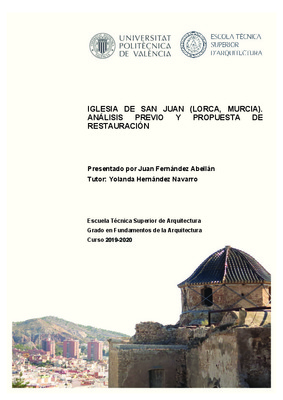|
Resumen:
|
[ES] La Iglesia de San Juan, situada en Lorca (Murcia) se trata de una edificación situada en la ladera de la montaña coronada por el castillo. Su construcción original en estilo gótico data del S XV, aunque tuvo posteriores ...[+]
[ES] La Iglesia de San Juan, situada en Lorca (Murcia) se trata de una edificación situada en la ladera de la montaña coronada por el castillo. Su construcción original en estilo gótico data del S XV, aunque tuvo posteriores modificaciones con los cambios de época.
Este es uno de los numerosos edificios dañados en la ciudad debido al temblor del 11 de mayo del 2011 que sacudió a esta localidad. Este edificio ya se encontraba en mal estado debido al desuso y vandalismo, el cual se agravó con el terremoto.
El objetivo principal del trabajo es aportar una solución para una restauración adecuada a los requisitos que nos plantea el estado ruinoso que presenta actualmente.
Para llegar a una óptima propuesta de restauración, se desarrolla un proceso de análisis de los puntos clave que han llevado a la Iglesia de San Juan desde su construcción hasta el estado en el que se encuentra ahora. En este punto se desarrollarán temas como su historia y su evolución a lo largo del tiempo, aportando documentación como planimetría y fotografías de un levantamiento gráfico para detallar las distintas fases y degradaciones.
Por otro lado se valoranrán estrategias que se han planteado anteriormente para su restauración, analizando la importancia que se le otorga a la historia, materialidad, uso, etc.
[-]
[EN] The church of San Juan, located in Lorca (Murcia) is a building located in the mountainside crowned with the castle. The first construction of this church was gothic and dates back to the 15th century, although it had ...[+]
[EN] The church of San Juan, located in Lorca (Murcia) is a building located in the mountainside crowned with the castle. The first construction of this church was gothic and dates back to the 15th century, although it had later modifications with upcoming eras.
This is one of the damaged buildings due to an earthquake the 11th of May in 2011, which shaked the whole city. This building was already in a poor condition due to the disuse and the vandalism, but it got worse with the earthquake.
The main objective of this project is to bring a solution for a restoration appropriated to the conditions posed by the dilapidated state that it has currently.
To come to a suitable proposal of restoration, an analysis process of the main reasons that changed the church from its original state until its current one is developed, also will be some items like its history and its evolution over the years in this point, bringing documentation such as planimetry and photographs to detail the different phases and degradations.
Alternatively, strategies that have been previously posed for its restoration will be valued, analysing the granted importance to the history, materiality, use and so on.
[-]
|







